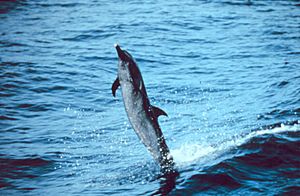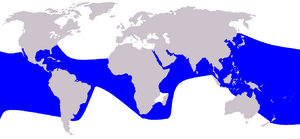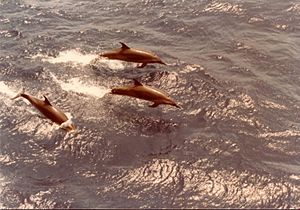Pantropical spotted dolphin facts for kids
Quick facts for kids Pantropical spotted dolphin |
|
|---|---|
 |
|
| Dolphin skipping on its tail over the water | |
 |
|
| Size compared to an average human | |
| Conservation status | |
| Scientific classification | |
| Genus: |
Stenella
|
| Species: |
attenuata
|
| Subspecies | |
|
|
 |
|
| Pantropical spotted dolphin range | |
The pantropical spotted dolphin (Stenella attenuata) is a type of dolphin that lives in warm and mild oceans all around the world. These dolphins were once in danger because millions were accidentally caught and killed in large nets used to catch tuna.
However, in the 1980s, new ways of catching tuna that were safer for dolphins helped save many of them. Today, the pantropical spotted dolphin is one of the most common dolphin species in the world.
Contents
What They Look Like
Pantropical spotted dolphins can look quite different depending on where they live. Dolphins living near the coast are usually larger and have more spots. Those living far out in the open ocean are often smaller.
Adult dolphins have many spots, which is how they get their name. However, young dolphins usually don't have spots and can sometimes be mistaken for bottlenose dolphins.
These dolphins have a long, thin snout. Their upper and lower jaws are dark, but they have thin, white "lips." Their chin, throat, and belly are white or light grey with only a few spots. Their sides have three different color bands: a light one at the bottom, a thin grey strip in the middle, and a dark grey back. Their tall, curved dorsal fin is also dark grey.
Where They Live
The pantropical spotted dolphin lives in all the warm and mild waters around the world. This means they are found in oceans and seas between about 40 degrees North and 40 degrees South of the equator.
There are more than three million pantropical spotted dolphins in the world. This makes them the second most common type of dolphin, after the bottlenose dolphin. About two million of them live in the eastern Pacific Ocean. However, this number is much lower than it used to be. In the 1950s, there were at least 7 million of these dolphins.
They like to live in shallow, warm waters where the temperature is usually above 25 degrees Celsius (77 degrees Fahrenheit). Sometimes, they might even swim into the Mediterranean Sea through the Suez Canal.
How They Behave
Pantropical spotted dolphins are very active and love to jump high out of the water, making big splashes. They often leap completely out of the sea for a second or more. They also enjoy swimming near boats and riding the waves created by the boat's front, which is called bow-riding.
Diet
These dolphins are not picky eaters! They mostly enjoy a diet of small fish that live near the surface of the ocean. They also like to munch on squid and even some crustaceans, which are like tiny ocean bugs.
Life Cycle
When a pantropical spotted dolphin is born, it is about 80 to 90 centimeters (about 3 feet) long. Adult dolphins can grow to be about 2.5 meters (about 8 feet) long and weigh around 120 kilograms (about 265 pounds).
Female dolphins can have babies when they are about 10 years old. Males are ready to mate when they are about 12 years old.
Lifespan
Pantropical Spotted Dolphins can live for a good long time! On average, they can live for about 40 years, which is a wonderful, long life exploring the ocean!
Different Kinds of Spotted Dolphins
Scientists recognize two main types, or "subspecies," of the Pantropical Spotted Dolphin:
- S. a. attenuata: This is the offshore pantropical spotted dolphin. "Offshore" means they live further out in the open ocean, and you can find them in tropical waters all over the world.
- S. a. graffmani: This is the coastal pantropical spotted dolphin. "Coastal" means they prefer to live closer to the shore. This subspecies is mainly found in the eastern tropical Pacific Ocean.
There's even another special group of these dolphins that lives near the Hawaiian islands, which scientists think might be another unique subspecies! It's amazing how much variety there can be within one species.
Dolphins and People
For a long time, the pantropical spotted dolphin's habit of swimming with yellowfin tuna was very dangerous for them.
In the 1960s and 1970s, fishermen in the eastern Pacific used very large nets called "purse seine nets" to catch tuna. Because of the pantropical spotted dolphin's habit of swimming with yellowfin tuna, many of them were accidentally caught in these nets too.
Sadly, because of these fishing methods, a very large number of dolphins were accidentally trapped and couldn't survive. Over about 25 years, a huge portion of the Pantropical Spotted Dolphin population in that region, and more than half of the world's total, was lost. This led to a big movement for "dolphin-friendly" tuna. This means that tuna is caught using special methods that make sure dolphins are not harmed. Many supermarkets now sell tuna that is certified "dolphin-friendly," which is a wonderful step forward! Organizations like the Whale and Dolphin Conservation Trust help approve these products.
Even with "dolphin-friendly" methods, there are still challenges. Fishing activities, even if they don't directly harm dolphins, can sometimes cause stress or separate mothers from their babies. This can make it harder for dolphin populations to grow and recover. For example, if a mother dolphin is separated from her calf, the calf might not survive, or the mother might have trouble having more babies.
Threats
Besides the historical tuna fishing issue, Pantropical Spotted Dolphins can face other threats:
- Gillnet Fisheries: These are nets that hang in the water like a wall. Dolphins can accidentally get tangled in them. This is a problem in places like Australia, Japan, Peru, and the Philippines.
- Trawls and Long-lining: These are other types of fishing gear that can accidentally catch dolphins.
- Small Catches: In some parts of the world, a small number of these dolphins are caught directly for human consumption, for example, in Japan, where an average of 71 dolphins were caught per year between 2010 and 2019.
Conservation
The good news is that many people and organizations around the world are working hard to protect Pantropical Spotted Dolphins and help their populations recover!
The Pantropical Spotted Dolphin is listed in Appendix II of the Convention on the Conservation of Migratory Species of Wild Animals (CMS). This means that countries agree to work together to protect these dolphins, especially since they travel across different ocean areas.
There are also special agreements like the Memorandum of Understanding Concerning the Conservation of the Manatee and Small Cetaceans of Western Africa and Macaronesia, and the Memorandum of Understanding for the Conservation of Cetaceans and Their Habitats in the Pacific Islands Region. These agreements help countries in specific regions work together to protect marine mammals.
Laws and Commissions
- U.S. Marine Mammal Protection Act (1972): This important law was created in the United States to protect marine mammals, including dolphins. Since this law was put in place, U.S. fishing vessels have done an amazing job, reducing accidental dolphin deaths by 95%! This shows that laws can make a huge positive impact.
- Inter-American Tropical Tuna Commission (IATTC): This commission helps manage tuna fishing in the eastern Pacific Ocean. They set limits on how many dolphins can be accidentally caught by the international fishing fleet. Thanks to their efforts, the number of accidental spotted dolphin deaths has gone down dramatically. For example, in 2005, only 373 spotted dolphin deaths were observed, which is a huge improvement from the past.
Even with all these efforts, the Pantropical Spotted Dolphin populations, especially the northeastern offshore group, are recovering slowly. Scientists believe dolphins can naturally increase their numbers by about 4% each year, but these specific populations haven't shown strong signs of recovery between 1979 and 2000, even after 30 years of management.
Interesting facts about the Pantropical spotted dolphin
- This dolphin was first described by a scientist named John Gray in 1846.
- The name "pantropical" means "found in all tropical regions."
- The scientific name for this dolphin Stenella attenuata comes from Latin words that mean "thin" or "thinning." This probably refers to their slender body shape or their thin dorsal fin.
- There are more than three million Pantropical Spotted Dolphins in the world. They are one of the most common dolphin species, especially in the Atlantic and Indian Oceans.
- They have the thinnest dorsal fin of all dolphin species.
- They are born without many spots and develop more and more as they get older, making each adult dolphin unique!
- Adult dolphins can grow to be about 2.5 meters (that's about 8 feet) long.
- They usually weigh between 110 to 140 kilograms (about 240 to 310 pounds).
- Interestingly, even though they often swim with yellowfin tuna, they don't usually eat tuna themselves! They just happen to like the same kind of food.
See also
 In Spanish: Delfín manchado tropical para niños
In Spanish: Delfín manchado tropical para niños




